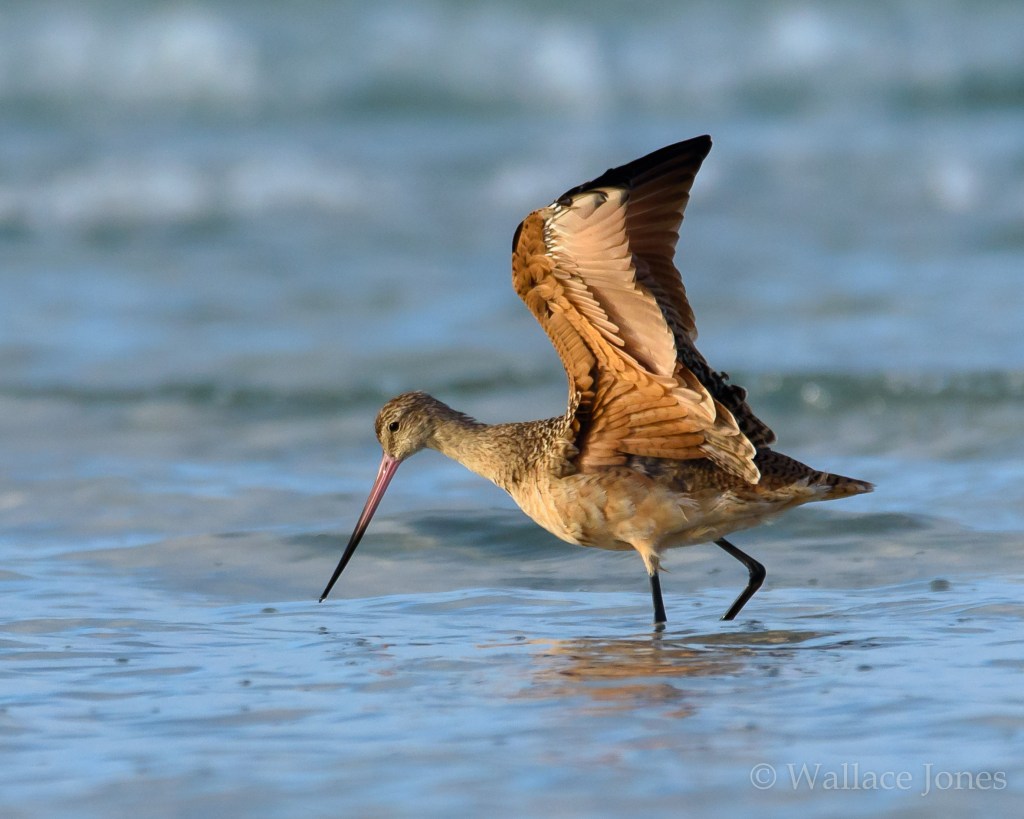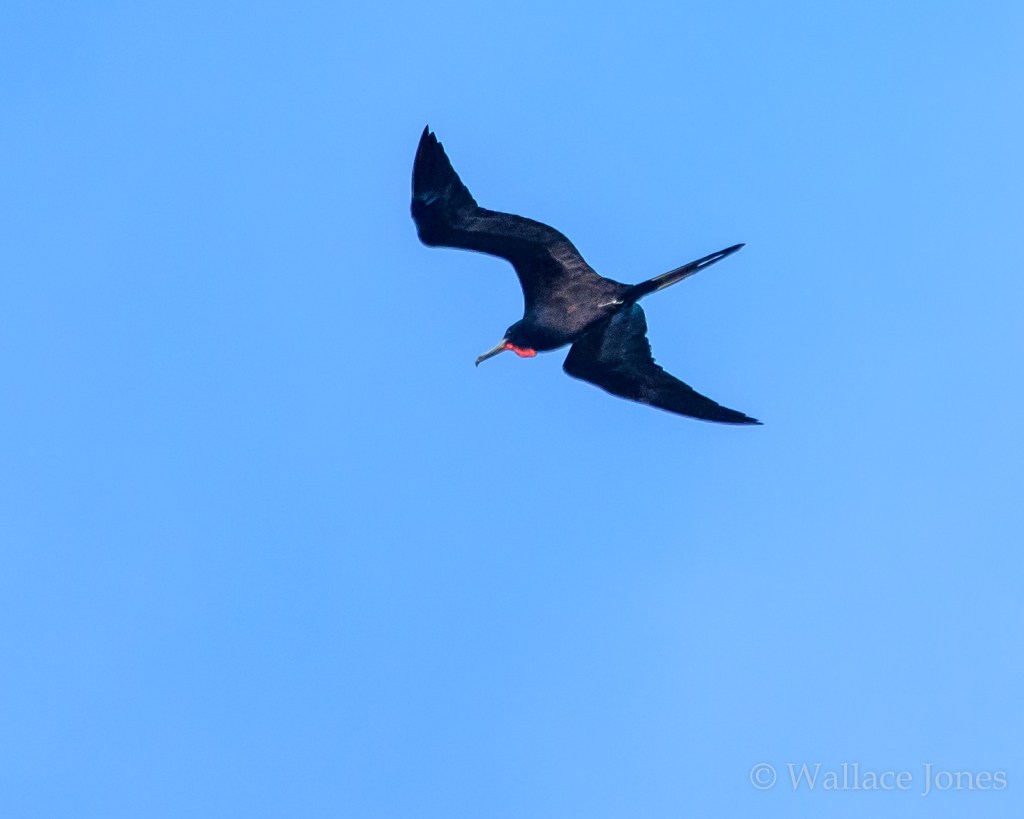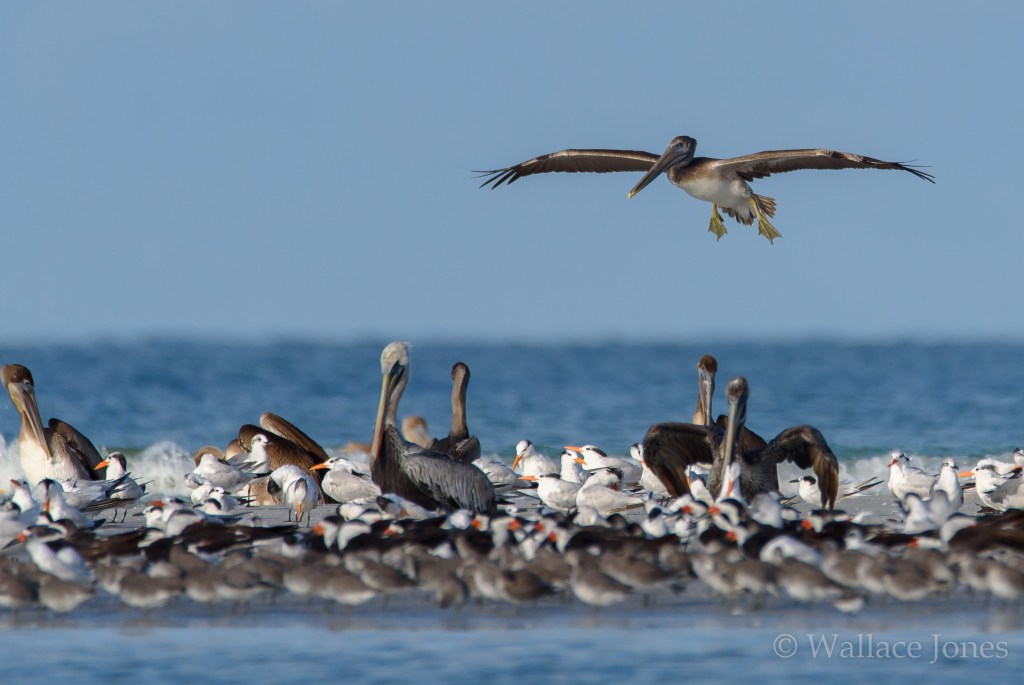Among The Birds – I
Is anticipation an emotion?
We had been traveling in darkness for about an hour. The eastern sky began to lighten and in the distance shadowy urban landscapes formed a backdrop for the expansive Tampa Bay. Scanning the water’s surface below the tall Sunshine Skyway Bridge, we hoped for a glimpse of dolphins, pelicans, terns or schools of sardines rippling the blue-green water. To the west, the lighthouse at Egmont Key faithfully flashed the beacon which identifies the entrance to Tampa Bay for ships arriving from around the planet.
From the apex of the big bridge, we coasted downhill toward our destination, Fort De Soto Park, bordering Tampa Bay and the Gulf of Mexico. Every light pole seemed to host an Osprey, some already picking at their freshly caught breakfast of mullet or sea trout. Squadrons of Brown Pelicans cruised across the highway. Laughing Gulls screeched their greeting to the rising sun.
Along the causeway leading to the park, Gini said: “Roll down the windows!” We took in gulps of salt air and arrived at the North Beach parking area just as the first rays of morning sun began to break above the tree line.
A few years ago, this location was prime “sun-bather beach” territory. Pristine white sand was continually refreshed by wave action from the gulf. Then geology and meteorology happened. Hurricanes can affect topography even if they don’t actually make landfall. Strong currents from off-shore storms combined with some pretty good blows which came ashore have altered this area completely. The once exposed beach is now protected by a series of sand-bars. Between beach and bars are shallow lagoons. The sun-bathers have migrated a bit south. Birds populate the sandbars in great numbers as they offer protection as well as a launching point for feeding in the gulf and along the shoreline.
I waded across the first lagoon, stopping to photograph a Marbled Godwit feeding in shallow water just a few yards from a pounding surf. The golden morning light enhanced the bird’s buffy plumage. Reaching an intermediate sandbar, I walked a short distance in the sugary sand and slipped into another lagoon and waded toward the outer bar which was packed with birds.
For the next couple of hours, it seemed I was in another world. Waist deep in the warm gulf water, I moved slowly, stopped often and was accepted by hundreds of birds as they did not consider me a threat.
Birding usually means observing birds through binoculars at some distance in order to avoid frightening the creatures into flight. This – this was something different. Being almost among the birds is a unique experience. Hearing the beating wings of a Black Skimmer as it takes off in search of food. Terns splashing head-first into the water mere feet from where I was standing. A glorious symphony produced by the chaotic cacophony of an incredibly diverse choir.
With so many birds jammed into the available space, attempting to photograph individual subjects was challenging. Patience and exploring eventually resulted in a few images. My weak efforts in no way provide a hint of the overwhelming delight provided by nature. For that, well, you will just have to go and get wet yourself.
Wrackline Reverie
Serenity is within our reach,
We find it among the shells at our secret beach
Where we struggle to form the words
Which describe the beauty of our birds.
The sun rises and warms the salty air;
If only we had the power to share
This serenity within our reach,
Paradise on earth, this, our beach.
Rich brown plumage highlighted by the early morning sunshine gave the Marbled Godwit a very special spotlight as she probed the shallow water within a few feet of waves crashing onto the sandbar.


Golden eyes reflect golden sunlight. A Great Egret patiently scans the waters for a potential meal.

Bobbing tail, crouched posture, always in a hurry – the Spotted Sandpiper loses the spots from its underside during the winter and is mostly gray above and white below.

With its shaggy black crest, clean white forehead (in non-breeding plumage) and black bill with yellow tip, a Sandwich Tern returns to the beach to enjoy a freshly caught breakfast snack.

Often seen in very large flocks on beaches (where they run in unison trying to avoid getting their feet wet), today most of the Sanderlings spotted were in small groups or singles, such as this one.

One of the three small sandpipers known collectively as “peeps”, the Western Sandpiper is about 6.5 inches (16.5 cm) long and has a drooping bill which is a bit longer on average than the other two (Least and Semipalmated Sandpiper).

A wingspan of up to 45 inches (115 cm) helps the Black Skimmer to cruise low as it keeps its outsized lower mandible just below the water’s surface ready to scoop up small fish and crustaceans. A Laughing Gull lounges to the right.

On a crowded sandbar, a huge Brown Pelican makes a landing. One has to admire whatever sort of flight control is involved in such a feat!

“Man-O-War Bird.” “Pirate of the sky.” Magnificent Frigatebirds are a joy to watch as they soar effortlessly over the water using their long forked tails to steer. Their nicknames, however, are well-earned. They will harass other birds mercilessly until they regurgitate or drop freshly caught food which the frigatebird retrieves in mid-air. The male has a red throat patch and the female a white breast.


The Semipalmated Plover nests in the Arctic and many will spend the winter on Florida’s beaches. This diminutive shorebird has been successful in diversifying its diet and habitat more than some of its cousins. As a result, its population has seen increases in the past few years.


Apparently, Ruddy Turnstones will also turn over seaweed when looking for a meal.

More Marbled Godwit candids. I couldn’t resist.



For such a large, ungainly-looking bird, Brown Pelicans certainly do appear graceful in flight. Landing – well – as a pilot friend once remarked, “any landing you walk (waddle?) away from is a successful one”.


They look plain and gray but when the Willet spreads its wings, a beautiful black and white striping is revealed. Some guy named John James Audubon advised they can be mighty tasty. Here, the Willet shares the breakfast buffet with a Marbled Godwit.

A medium to large heron, Reddish Egrets probably number less than 5,000 within the United States. Their distinctive “dance” while foraging is an unforgettable experience.

My strategy emulated the herons this morning as I steadily plodded along the shoreline, entered the water up to my waist (which helped to photograph birds on the sandbar close to eye-level), slowly moved along the lagoon, holding still for long periods – all helped the birds remain calm as they went about their daily routine. I know, it’s a lot of pictures. With more to come. Total images for the day = 725. Be thankful I’m only forcing you to look at a few!
Up next, more terns, more gulls, Big Red with an attitude and a rare European tourist!
To be continued …..
Additional Information
What a wonderful post – so many birds I would love to see. And after being in a COVID lockdown of some form for most of this year, I can tell you that anticipation is an emotion!
Hope all is well – Stewart M – Melbourne
LikeLike
G’Day Stewart! Thank you.
Yes, for many, these times have shown there may be a not-so-fine line between “anticipation” and “dreams”. We truly hope all of us will be able to turn “anticipation” into “reality” – sooner rather than later.
All is very well here.
LikeLike
This is a wonderful set of pictures, Wally, all meritorious, but the Marbled Godwit images stand out for me. And the Magnificent Frigatebirds in flight are…well…magnificent. Any time you can effectively become part of the scenery birds become amazingly confiding, and you just proved this point. One of my memorable occurrences while sitting quietly on a rock amid an aspen/birch forest on the Canadian Shield was to have an Ovenbird casually walk over my foot, and a Pileated Woodpecker hammering so close it was showering wood chips on me,
LikeLike
Thank you, David. It was a very good day!
Blending in certainly helps put many creatures at ease. When I worked in Washington, D.C., I turned into a chameleon.
Would much prefer an Ovenbird on the foot anytime!
LikeLike
Hello Wally,
Looks like an awesome day at the park. I see so many favorites, like the Godwit and the Pelicans. The Plovers are so cute. The Black Skimmers are another favorite. Your photos are awesome. Have a great day!
LikeLike
Thank you, Eileen. It really was a good day. Here’s hoping we all have more like it!
LikeLiked by 1 person
These are fabulous captures and wonderful post, Wally. The best Marbled Godwit captures I’ve ever seen. ❤ Can’t wait to see what more you have to share!
On your tip, I visited Babcock Webb WMA yesterday. 🙂 Hunting season has started so only the paved road was open. I’m still going through my photos, I’m hoping I got some great shots.
LikeLike
Thank you very much, Donna!
Oops! Totally forgot about the hunters. Looking forward to seeing what you found.
LikeLiked by 1 person
So that’s where you’ve been hiding out? That is some find Wally. And great photos today. You really excelled with those godwits. And I thought our Black-tailed had a long bill. I remember being in awe of those pre-history Magnificent Frigatebirds the way they beat up everything around them. Guess what? It’s raining here and blowing a hoolie. Could do with some of your sun and temperatures. Guess I’ll go and open a bottle and put the steak and chips on.
LikeLike
Thank you, Phil. It was a fun day.
We’ll try to figure out a way to package up a bit of sun to send your way.
Enjoy the steak!
LikeLike
What a lovely post! The photos are beautiful, one thing I noticed about this series of birds was the beaks…almost all of the birds you featured today have nice long beaks! 🙂
LikeLike
Thank you for your very kind comments!
Those beaks help probe the soft sand and mud and in some cases grab and stab fish in the water.
LikeLike
I seem to remember that, quite recently, I said that I had difficulty getting past your wonderful header image, Wally. Then you came up with this one, and I got stuck there for even longer – truly amazing!
I cannot think of anywhere natural in UK where there is the safe possibility of wading waist-deep in water with a camera – even without birds to photograph. Add in the cold water factor, and it’s an absolute non-starter. Transported to Fort De Soto Park, it would probably never have crossed my mind to do what you did – unless I had you as a guide!
What fabulous results you got from your initiative. It was good to see Sanderling thousands of miles from where I saw them not so long ago. My favourites, however, purely because they are so different to anything I see in UK, have to be the Pelicans, Skimmers, and Frigatebirds.
This post was a wonderful start to my weekend – thank you.
Have a great weekend and week ahead. I hope that the political scene over there settles down soon, for the sake of all of us.
Best wishes to you and Gini – – – Richard
LikeLike
My morning cuppa was much sweeter today due to your comments, Richard. Thank you!
We were blessed to have grown up fishing, swimming and exploring these warm gulf waters. There still exists a magnet which pulls me in when I’m near.
Gini and I hope you and Lindsay are managing the difficult times. We’ll send another blast of tropical waters and birds soon!
LikeLike
It took me a while to figure out what it was — apart from your skill and your willingness to wade — that made this set of photos so glorious. I finally got it: the water. Because so many muddy rivers drain into the Gulf beaches here, and because our marshes are continually stirred up by wind, brown water’s the name of the game. For whiskey, that’s fine. For photography? Not so much. I think things are different farther south, from the mid-coast to Brownsville. Padre Island certainly is white sand/blue water territory.
I was astonished to read how few reddish egrets remain. I think I might have a photo of one from the Brazoria refuge, but I can’t locate it just now. Your photos of the ‘little birds’ are especially pleasing. Maybe one day I’ll be able to tell a sandpiper from a plover.
LikeLike
It is a satisfying thing to remember several decades ago wading waist-deep in this same area where the water was so clear I could see my feet – and can still do so in today’s clear gulf water!
LikeLiked by 1 person
So many great shots! I hope you got to see the white pelicans. It’s funny you noticed the osprey on the bridge. I cross that bridge going to work and use to count them in the mornings. The most I counted was 22 one morning.
LikeLike
Thank you, Dina. If I didn’t see those sentinel Osprey, I would be worried!
LikeLike
Of course anticipation is an emotion. And a strong one.
And yours (and ours) was bountifully rewarded.
Many thanks for the feathered enchantment that your posts always bestow on me.
I do think that pelicans show their dinosaur ancestors – perhaps more than most. And love them.
LikeLike
Many thanks, EC!
I agree about the pelicans. Unique creatures!
LikeLike
Absolutely amazing!
LikeLike
Thank you so much! It WAS amazing! All those birds posing – okay, that was a fantasy…..
LikeLike
Wow! I was with you every step of the way. (Need to towel off my lower half and shake off the sand). You painted a seascape with your words. Loved coasting down from the middle of that bridge. The Godwits look so good in the morning light. And there is more to come!
LikeLiked by 1 person
Since I’ve been salivating over your recent superb photographs, Ken, I appreciate the high praise!
I was a good day.
LikeLike
Stunning shots and a beautifully told account of what must have been a memorable day, wow I wish I was with you in person!
Thank for a great post Wally.
LikeLike
Bring old shoes.
Thank you very much, Brian!
LikeLiked by 1 person